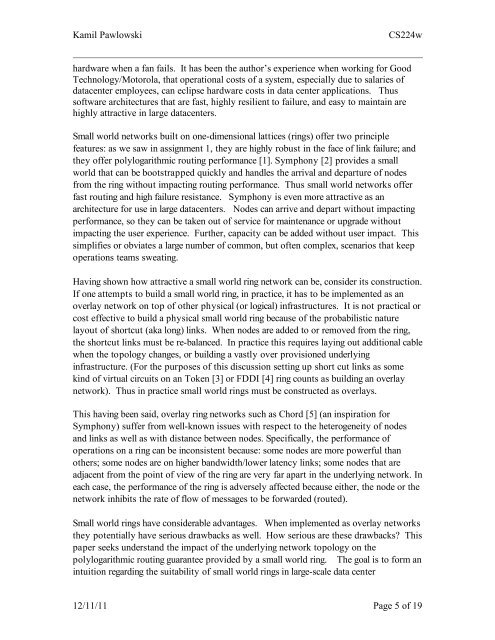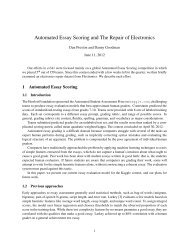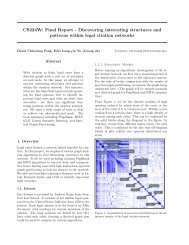Small World Overlay Networks - SNAP
Small World Overlay Networks - SNAP
Small World Overlay Networks - SNAP
Create successful ePaper yourself
Turn your PDF publications into a flip-book with our unique Google optimized e-Paper software.
Kamil Pawlowski CS224w<br />
hardware when a fan fails. It has been the author’s experience when working for Good<br />
Technology/Motorola, that operational costs of a system, especially due to salaries of<br />
datacenter employees, can eclipse hardware costs in data center applications. Thus<br />
software architectures that are fast, highly resilient to failure, and easy to maintain are<br />
highly attractive in large datacenters.<br />
<strong>Small</strong> world networks built on one-dimensional lattices (rings) offer two principle<br />
features: as we saw in assignment 1, they are highly robust in the face of link failure; and<br />
they offer polylogarithmic routing performance [1]. Symphony [2] provides a small<br />
world that can be bootstrapped quickly and handles the arrival and departure of nodes<br />
from the ring without impacting routing performance. Thus small world networks offer<br />
fast routing and high failure resistance. Symphony is even more attractive as an<br />
architecture for use in large datacenters. Nodes can arrive and depart without impacting<br />
performance, so they can be taken out of service for maintenance or upgrade without<br />
impacting the user experience. Further, capacity can be added without user impact. This<br />
simplifies or obviates a large number of common, but often complex, scenarios that keep<br />
operations teams sweating.<br />
Having shown how attractive a small world ring network can be, consider its construction.<br />
If one attempts to build a small world ring, in practice, it has to be implemented as an<br />
overlay network on top of other physical (or logical) infrastructures. It is not practical or<br />
cost effective to build a physical small world ring because of the probabilistic nature<br />
layout of shortcut (aka long) links. When nodes are added to or removed from the ring,<br />
the shortcut links must be re-balanced. In practice this requires laying out additional cable<br />
when the topology changes, or building a vastly over provisioned underlying<br />
infrastructure. (For the purposes of this discussion setting up short cut links as some<br />
kind of virtual circuits on an Token [3] or FDDI [4] ring counts as building an overlay<br />
network). Thus in practice small world rings must be constructed as overlays.<br />
This having been said, overlay ring networks such as Chord [5] (an inspiration for<br />
Symphony) suffer from well-known issues with respect to the heterogeneity of nodes<br />
and links as well as with distance between nodes. Specifically, the performance of<br />
operations on a ring can be inconsistent because: some nodes are more powerful than<br />
others; some nodes are on higher bandwidth/lower latency links; some nodes that are<br />
adjacent from the point of view of the ring are very far apart in the underlying network. In<br />
each case, the performance of the ring is adversely affected because either, the node or the<br />
network inhibits the rate of flow of messages to be forwarded (routed).<br />
<strong>Small</strong> world rings have considerable advantages. When implemented as overlay networks<br />
they potentially have serious drawbacks as well. How serious are these drawbacks? This<br />
paper seeks understand the impact of the underlying network topology on the<br />
polylogarithmic routing guarantee provided by a small world ring. The goal is to form an<br />
intuition regarding the suitability of small world rings in large-scale data center<br />
12/11/11 Page 5 of 19
















